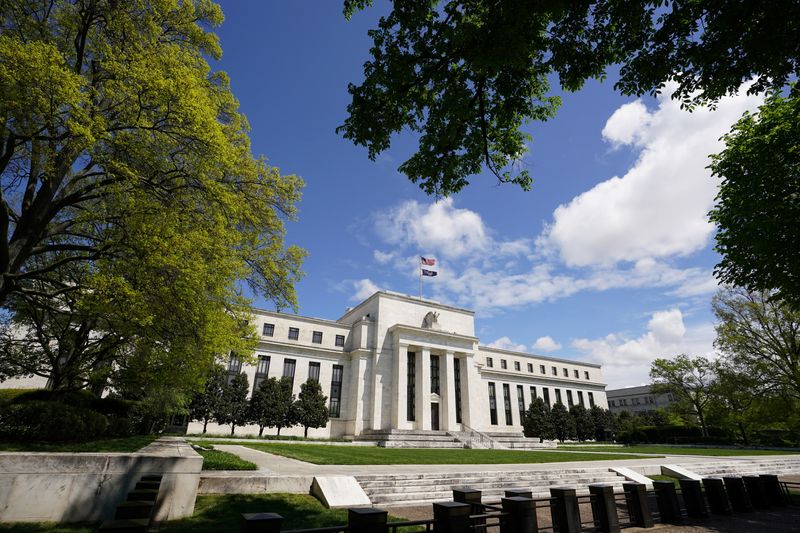By Paritosh Bansal
(Reuters) -Some Wall Street executives feel a tantrum coming in U.S. short-term financing markets, perhaps as soon as March. It could put pressure on the Federal Reserve to ease policy.
A series of events are expected between March and May, some of which will reduce the amount of cash in the financial system, while others increase the demand for liquidity, according to interviews with four banking executives.
A Fed lending facility that was put in place after the regional banking crisis last year will expire on March 11, with $129 billion outstanding. That will remove what has become an attractive source of funding for banks. Another market backstop, called the standing repo facility (SRF), that Fed officials have held up as a safety net has seen only a few banks sign up so far.
At the same time, the demand for cash is likely to increase, with the issuance of massive quantities of U.S. government debt and quarterly tax payments due on March 15 and annual payments due on April 15. In addition, a move in May toward faster settlement of trades could increase demand for short-term funding as firms that are not fully prepared to make the transition would need more overnight financing.
All this is happening as the Fed has been steadily draining cash from the financial system by offloading bonds from its balance sheet, unwinding its pandemic-era support to the economy. BNY Mellon (NYSE:BK) strategists estimate the amount of cash parked overnight with the Fed by money market funds and others – funds seen as excess liquidity – could dip below $200 billion by May, a tenth of what it was in June last year. Some expect this facility, called overnight reverse repurchase agreements, could drain to zero by mid-year.
Any stress is likely to show up in short-term financing markets. Interest rates in repurchase agreements, or repo, where investors borrow against Treasury and other collateral, spiked briefly at the end of November and December. While market participants initially attributed the increase to other factors, the bankers said liquidity has been coming into sharper focus.
"Liquidity could start to show some cracks as funding needs continue to grow," said James Tabacchi, CEO of South Street Securities, an independent broker dealer active in Treasury markets. "It is a balancing act, and it won't take a lot to cause a disruption in the funding markets."
FED IS WATCHING
Sudden spikes in short-term financing markets, especially if they are sustained, can pose a threat to financial stability as it becomes harder -- and more expensive -- for firms that need the money the most to get it. This time around, for example, it could expose any lenders that have not managed to stabilize their deposits after last year's banking crisis.
The confluence of these factors also underscores how the risk of policy error is increasing as the Fed gets closer to its target inflation rate of 2%.
A market meltdown, depending on the degree of its intensity, could serve as a signal to the Fed that it is time to ease policy. Slowing the pace of quantitative tightening is seen by some strategists as a possible policy response.
While rate cuts are a separate policy matter, markets are also betting that the Fed will start cuts by May despite central bankers saying they need to see more data.
Policymakers are watching, but it is not yet clear what they might do, if anything.
Last week, Federal Reserve Governor Christopher Waller said there was no reason for the Fed's reverse repo facility to have anything in it. Asked when the Fed would start slowing the pace of QT, he said: "I would say sometime this year will be a reasonable thing to start thinking about it."
Waller said usage of the Fed's standing repo facility, which at the moment is not being drawn, would be an indicator that liquidity was getting tight. He held it up as a backstop that would prevent things from going out of hand.
A Fed spokesperson declined to comment.
MARKET SIGNAL
Amalgamated Bank (NASDAQ:AMAL), with about $8 billion in assets, enhanced its contingency planning exercise this year to take into account more unlikely scenarios, CFO Jason Darby said.
For example, the executive said, the bank had planned for what if some of their typical funding sources, such as the Federal Home Loan Banks, were suddenly not available.
"That's a very unlikely scenario," Darby said. "But I believe companies are doing themselves good service by thinking through more draconian situations and making sure that they've got adequate liquidity options."
The bank has been using the Fed's Bank Term Funding Program, the facility that expires in March, to a modest extent and is considering rolling over a loan that matures before the deadline for another year to take advantage of its terms.

In September 2019 repo rates spiked due to lack of liquidity, forcing the Fed to act. John Velis, forex and macro strategist for the Americas at BNY Mellon, said the repo blow up at the time "really started to hit home" as quarterly corporate taxes came due that month.
"We don't know when we get to that point from abundant" to insufficient liquidity, Velis said. "The market will tell us."